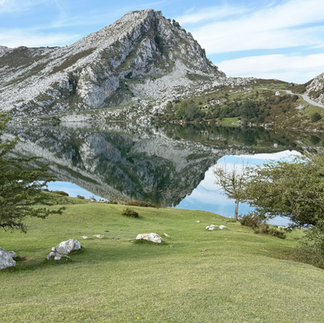Covadonga Lakes: A Journey Through Asturias’s Natural Crown Jewel
- kweiquartey
- Oct 12
- 3 min read
Updated: Nov 4
Exploring the Covadonga Lakes: Nature's Hidden Gem in Northern Spain
Introduction
The Covadonga Lakes in northern Spain are more than just a scenic stop—they’re a geological record. Set high in the Picos de Europa mountains, these lakes were carved by glaciers thousands of years ago. Today, the area draws visitors for its layered history: the battle that began the Reconquista, the basilica built into the landscape, and the stark white limestone that frames every view.

Glacial Origins of Covadonga Lakes
Roughly 20,000 years ago, during the Last Glacial Maximum, massive ice sheets shaped what are now Lago Enol, Lago Ercina, and Lago Bricial. The glaciers gouged out deep depressions in the limestone bedrock, which filled with meltwater as the climate warmed.
The lakes are fed by underground springs and snowmelt from the surrounding mountains. Bricial—once the third lake—now only holds water during periods of snowmelt or heavy rainfall. Persistent climate change and reduced snowpack have made its seasonal presence shorter each year.
Why the White Limestone Matters
The striking white patches visible on the mountainsides might look like snow at first glance, but they are really limestone outcrops.

This karst landscape is porous, meaning water seeps underground rather than forming rivers on the surface. That’s why the lakes seem to appear suddenly, like mirrors dropped into the green pastures. The limestone also gives the water its clear, reflective quality.
The surrounding environment is a high-altitude pasture, with native cattle grazing in summer. This pastoral use has coexisted with the landscape for centuries, shaping the open meadows visitors see today.
Covadonga Lakes — Nature’s Reflecting Pools
A winding mountain road leads to Lago Enol and Lago Ercina, the twin jewels of Covadonga. On calm days, the surrounding peaks reflect perfectly on the lake’s surface, creating a surreal, mirror-like landscape.
Grazing cattle roam freely across the emerald meadows, adding a timeless pastoral charm. It’s no wonder this site is often called the “crown of Asturias."
The Fragile Ecosystem of the Covadonga Lakes
Like many alpine environments, Covadonga Lakes are vulnerable to climate shifts. Higher temperatures, less snow, and changing water cycles threaten the hydrological balance that has sustained these lakes for millennia. What’s now a postcard-perfect view could look very different in the future.
Pelayo and the Birthplace of a Legend
The historical weight of this site is just as striking as the geology. A statue of Pelayo, the Asturian noble who defeated Moorish forces in 722 CE, stands at the entrance to Covadonga.

His victory marked the start of the Christian Reconquista. Nearby, the Basilica de Santa María la Real de Covadonga, built from pink limestone, anchors the site in both faith and national mythology.
The Basilica of Covadonga — Faith Carved in Stone
Just steps away stands the Basilica de Santa María la Real de Covadonga, built in the 19th century from pink limestone, its twin spires piercing the Asturian sky. This neo-Romanesque structure honors the Virgin of Covadonga, a sacred figure deeply rooted in regional identity. Pilgrims and travelers alike come here not only for faith—but for the breathtaking architecture set against rugged mountain slopes.


The Experience of Visiting Covadonga
What struck me most about the tour wasn’t so much the Basilica. It was the mountains—the Covadonga air so pure and cold it almost startled my lungs at first. It was clean in a manner you don’t get in cities. Semi-wild horses graze across the meadows, and the steady clank of cowbells carries through the valley with a calming rhythm. The feeling of tranquility is incomparable, and one leaves feeling cleansed.
How to Get There
🚍 By Tour: Buendía Tours offers comfortable and expertly guided excursions from Oviedo and other major cities in Asturias.
🚗 By Car: The road is open outside high season, but during peak months, access is controlled—buses and shuttles are available.
👣 On Foot: For the adventurous, several hiking trails wind through the surrounding national park.
Best Times to Visit the Covadonga Lakes
Spring–Early Autumn: Lush green landscapes and clear skies.
Early Morning: Best light and reflection on the lakes.
Late September–October: Fewer crowds, crisp air, and golden foliage.
Conclusion: The Lasting Allure of Covadonga
The Covadonga Lakes are not just a destination; they are a journey through time and nature. The interplay of history, geology, and spirituality creates a unique tapestry that invites exploration. Whether you are captivated by the stunning landscapes or the rich history, Covadonga offers something for everyone. I can’t help but feel a sense of wonder every time I visit.
References & Further Reading
⭐ Don’t forget to follow me on Instagram for more content: @kweiquarteyauthor! ⭐














